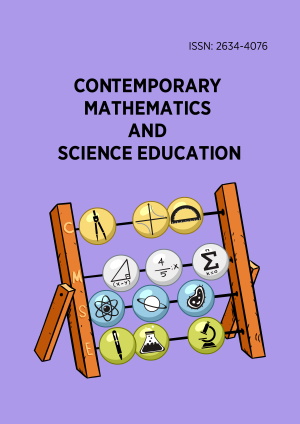Research Article
A model for scaffolding mathematical problem-solving: From theory to practice
More Detail
1 National Institute of Education, Nanyang Technological University, Nanyang Walk, SINGAPORE* Corresponding Author
Contemporary Mathematics and Science Education, 4(2), July 2023, ep23019, https://doi.org/10.30935/conmaths/13308
Published Online: 25 May 2023, Published: 01 July 2023
OPEN ACCESS 3443 Views 3179 Downloads
ABSTRACT
Devising a plan is an important phase in the teaching and learning of mathematical problem-solving in a mathematics classroom. In this paper, we propose devise a plan (DP) model for scaffolding students in devising a plan to engage them in mathematical problem-solving for classroom instruction and beyond. Although mathematics educators have proposed problem-solving scaffold, mainly building on Polya’s (1945) and Schoenfeld’s (1985) problem-solving models, for authentic problem-solving in the classroom, the phase on devising a plan was generally brief. We expand on the scaffolding of the intermediate stages of devising the plan for teachers to teach problem-solving, with a more ambitious goal of enabling students to engage in independent problem-solving beyond the classrooms. Features that are used in the planning stage of problem-solving are identified through a systematic literature review. Our proposed DP model includes the use of both metacognitive strategies and problem-solving heuristics. The application of our proposed model was exemplified by the solution of three non-routine problem on proportionality.
CITATION (APA)
Tay, Y. K., & Toh, T. L. (2023). A model for scaffolding mathematical problem-solving: From theory to practice. Contemporary Mathematics and Science Education, 4(2), ep23019. https://doi.org/10.30935/conmaths/13308
REFERENCES
- Anderson-Krathwohl, D. R., & Bloom, B. S. (2001). A taxonomy for learning, teaching, and assessing: A revision of Bloom’s taxonomy of educational objectives. Longman.
- Australian Education Council. (1990). A national statement on mathematics for Australian schools. Curriculum Corporation for Australian Education Council.
- Bos, R. (2017). Supporting problem solving through heuristic trees in an intelligent tutoring system. In G. Aldon, & J. Trgalova (Eds.), Proceedings of the 13th International Conference on Technology in Mathematics Teaching (pp. 436-439). Springer. https://doi.org/10.1007/978-3-030-19741-4
- Bos, R., & van den Bogaart, T. (2022). Heuristic trees as a digital tool to foster compression and decompression in problem-solving. Digital Experiences in Mathematics Education, 8(3), 157-182. https://doi.org/10.1007/s40751-022-00101-6
- Cockcroft Report. (1982). Mathematics counts. Her Majesty’s Stationary Office.
- Enright, B., & Beattie, J. (1989). Problem solving step by step in math. TEACHING Exceptional Children, 22(1), 58-59. https://doi.org/10.1177/004005998902200115
- Freeman-Green, S. M., O’Brien, C. L., Wood, C., & Hitt, S. B. (2015). Effects of the SOLVE strategy on the mathematical problem solving skills of secondary students with learning disabilities. Learning Disabilities Research & Practice, 30(2), 76-90. https://doi.org/10.1111/ldrp.12054
- Jitendra, A. K., Hoff, K., & Beck, M. M. (1999). Teaching middle school students with learning disabilities to solve word problems using a schema-based approach. Remedial and Special Education, 20(1), 50-64. https://doi.org/10.1177/074193259902000108
- Jitendra, A. K., Star, J. R., Starosta, K., Leh, J. M., Sood, S., Caskie, G., Hughes, C. L., & Mack, T. R. (2009). Improving seventh grade students’ learning of ratio and proportion: The role of schema-based instruction. Contemporary Educational Psychology, 34(3), 250-264. https://doi.org/10.1016/j.cedpsych.2009.06.001
- Jung, E., Lim, R., & Kim, D. (2022). A schema-based instructional design model for self-paced learning environments. Education Sciences, 12(4), 271. https://doi.org/10.3390/educsci12040271
- Kahneman, D. (2011). Thinking, fast and slow. Farrar, Straus and Giroux.
- Lemmink, R. M. A. Z. (2019). Improving help-seeking behavior for online mathematical problem-solving lessons [Master’s thesis, Utrecht University].
- Leong, Y. H. (2009). Problems of teaching in a Singapore reform-oriented mathematics classroom. Lambert Academic Publishing.
- Leong, Y. H., Lu, P. C., & Toh, W. Y, K. (2021). Use of challenging items in instructional materials by Singapore secondary school mathematics teachers. In B. Kaur, & Y. H. Leong (Eds.), Mathematics instructional practices in Singapore secondary schools (pp. 231-248). Springer. https://doi.org/10.1007/978-981-15-8956-0_12
- Mason, J., Burton, L., & Stacey, K. (1982). Thinking mathematically. Addison-Wesley Publishing Company.
- NCTM. (1989). Principles and standards for school mathematics. National Council of Teachers of Mathematics.
- Polya, G. (1945). How to solve it. Princeton University Press. https://doi.org/10.1515/9781400828678
- Popham, M., Adams, S., & Hodge, J. (2020). Self-regulated strategy development to teach mathematics problem solving. Intervention in School and Clinic, 55(3), 154-161. https://doi.org/10.1177/1053451219842197
- Reid, R., Lienemann, T. O., & Hagaman, J. L. (2014). Strategy instruction for students with learning disabilities. Guilford.
- Renkl, A., Atkinson, R. K., & Große, C. S. (2004). How fading worked solution steps works–A cognitive load perspective. Instructional Science, 32(1/2), 59-82. https://doi.org/10.1023/B:TRUC.0000021815.74806.f6
- Roll, I., Baker, R. S. J. D., Aleven, V., & Koedinger, K. R. (2014). On the benefits of seeking (and avoiding) help in online problem-solving environments. Journal of the Learning Sciences, 23(4), 537-560. https://doi.org/10.1080/10508406.2014.883977
- Rott, B., Specht, B., & Knipping, C. (2021). A descriptive phase model of problem-solving processes. ZDM Mathematics Education, 53(4), 737-752. https://doi.org/10.1007/s11858-021-01244-3
- Schoenfeld, A. H. (1985). Mathematical problem solving. Academic Press.
- Toh, T. L. (2011). Making mathematics practical: an approach to problem solving. World Scientific. https://doi.org/10.1142/8171
- Toh, T. L., Quek, K. S., & Tay, E. G. (2008a). Mathematical problem solving–A new paradigm. Connected maths: MAV yearbook, 356-365.
- Toh, T. L., Quek, K. S., & Tay, E. G. (2008b). Problem solving in the mathematics classroom (junior college). National Institute of Education, Nanyang Technological University.
- Wilson, J. W., Fernandez, M. L., & Hadaway, N. (1993). Mathematical problem solving. In P. S. Wilson (Ed.), Research ideas for the classroom: High school mathematics (pp. 57-77). MacMillan.

 The articles published in this journal are licensed under the CC-BY Creative Commons Attribution International License.
The articles published in this journal are licensed under the CC-BY Creative Commons Attribution International License.